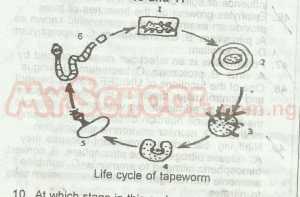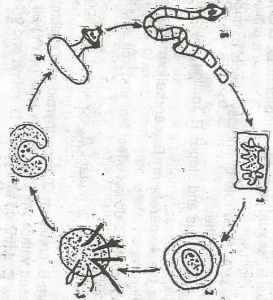Year :
1988
Title :
Biology
Exam :
JAMB Exam
Paper 1 | Objectives
41 - 50 of 50 Questions
| # | Question | Ans |
|---|---|---|
| 41. |
Which of these groups of animals is likely to be found in fresh water? A. Blood worm, pond skater and scorpion B. Blood worm, pond skater and dragonfly larva C. pond skater, scropion and dragonfly larva D. Pond skater, blood worm and ant-lion |
B |
| 42. |
One of the characteristics of plants in the savanna is the A. possession of thin, smoth barks B. possession of large tap root C. production of seedlings on mother plant D. possession of thick, flaky bark |
D |
| 43. |
Which of the following diseases can be contracted in areas with fast flowing rivers? A. Schistosomiasis B. Elephantiasis C. Syphilis D. Onchoceriasis Detailed SolutionOnchocerciasis, also known as river blindness and Robles disease, is a disease caused by infection with the parasitic worm Onchocerca volvulus. Symptoms include severe itching, bumps under the skin, and blindness |
|
| 44. |
Which of the following causes pollution? A. Consumption of canned drink B. The addition of fertilizer to farmland C. Respiration of living organism D. Burning of refuse |
D |
| 45. |
The mineral nutrient that is most bound to the soil is A. phosphorus B. calcium C. iron D. potassium |
C |
| 46. |
The mineral nutrient that easily gets leached out of the soil is A. phosphorus B. calcium C. magnesium D. nitrate |
D |
| 47. |
Most commercial fertilizers are rich in salts of A. sodium, iron and calcium B. nitrogen, phosphorus and potassium C. iron, copper and nitrogen D. calcium, sodium and phosphorus |
B |
| 48. |
Dead plants and animals are decomposed by bacteria and fungi into A. nitrate B. nitrites C. amino acids D. ammonium Detailed SolutionWhen a plant or animal dies or an animal expels waste, the initial form of nitrogen is organic. Bacteria or fungi convert the organic nitrogen within the remains back into ammonium \(NH^{+}_{4}\), a process called ammonification. |
|
| 49. |
 At what stage in this cycle can man be infected? A. 2 B. 4 C. 5 D. 6 |
B |
| 50. |
 Which stage is found in the muscle of an infected pig? A. 3 B. 4 C. 5 D. 6 |
A |
| 41. |
Which of these groups of animals is likely to be found in fresh water? A. Blood worm, pond skater and scorpion B. Blood worm, pond skater and dragonfly larva C. pond skater, scropion and dragonfly larva D. Pond skater, blood worm and ant-lion |
B |
| 42. |
One of the characteristics of plants in the savanna is the A. possession of thin, smoth barks B. possession of large tap root C. production of seedlings on mother plant D. possession of thick, flaky bark |
D |
| 43. |
Which of the following diseases can be contracted in areas with fast flowing rivers? A. Schistosomiasis B. Elephantiasis C. Syphilis D. Onchoceriasis Detailed SolutionOnchocerciasis, also known as river blindness and Robles disease, is a disease caused by infection with the parasitic worm Onchocerca volvulus. Symptoms include severe itching, bumps under the skin, and blindness |
|
| 44. |
Which of the following causes pollution? A. Consumption of canned drink B. The addition of fertilizer to farmland C. Respiration of living organism D. Burning of refuse |
D |
| 45. |
The mineral nutrient that is most bound to the soil is A. phosphorus B. calcium C. iron D. potassium |
C |
| 46. |
The mineral nutrient that easily gets leached out of the soil is A. phosphorus B. calcium C. magnesium D. nitrate |
D |
| 47. |
Most commercial fertilizers are rich in salts of A. sodium, iron and calcium B. nitrogen, phosphorus and potassium C. iron, copper and nitrogen D. calcium, sodium and phosphorus |
B |
| 48. |
Dead plants and animals are decomposed by bacteria and fungi into A. nitrate B. nitrites C. amino acids D. ammonium Detailed SolutionWhen a plant or animal dies or an animal expels waste, the initial form of nitrogen is organic. Bacteria or fungi convert the organic nitrogen within the remains back into ammonium \(NH^{+}_{4}\), a process called ammonification. |
|
| 49. |
 At what stage in this cycle can man be infected? A. 2 B. 4 C. 5 D. 6 |
B |
| 50. |
 Which stage is found in the muscle of an infected pig? A. 3 B. 4 C. 5 D. 6 |
A |